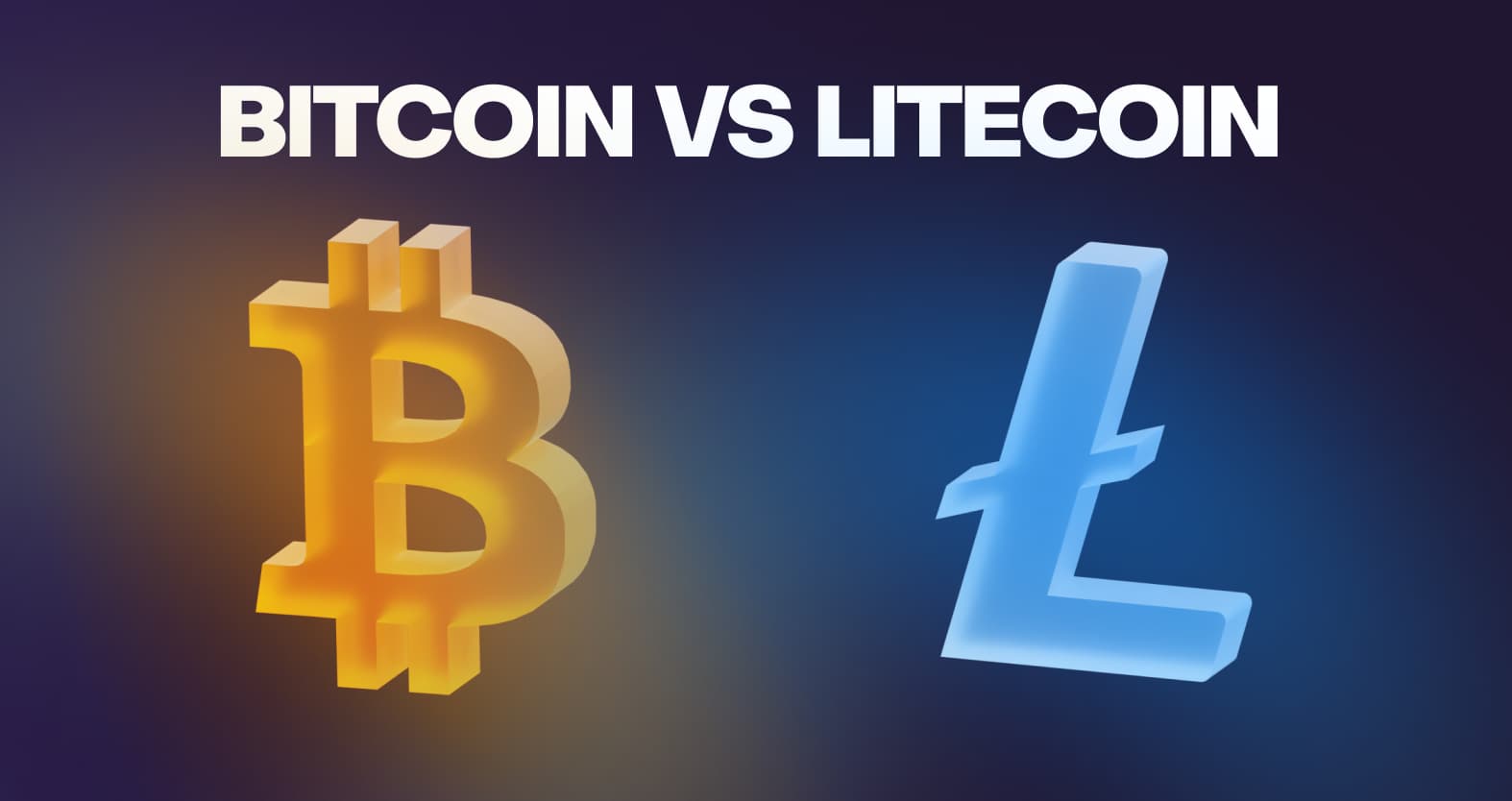
Table of contents
Bitcoin and Litecoin are two of the most popular cryptocurrencies around today. Because Litecoin took the original code base of Bitcoin and modified it, they have similar yet have many unique qualities.
Litecoin is an open-source code hard fork of Bitcoin. This means it was created from a copy of Bitcoin's source code rather than a contentious split-off from the Bitcoin blockchain because of community misalignments. A hard fork means that Litecoin carries over some of Bitcoin's properties, despite being its own independent blockchain network. However, Litecoin implements some core changes that fundamentally alter the way transactions work. Let's break down the similarities between the two networks.
Similarities Between Bitcoin and Litecoin
Considering Litecoin is a hard fork of Bitcoin, it makes sense that they function quite similarly.
Consensus Method
Both have a Proof of Work consensus method. Basically, people who do cryptocurrency mining are paid in the networks' respective native coins to validate blocks full of transactions. Miners have powerful computers that put in the "work", i.e., computing power and electricity, to validate blocks, and that's how the blockchain is secured.
Proof of Work used to be the most popular blockchain consensus mechanism, but many networks are now switching to the seemingly more sustainable Proof of Stake. Many believe that Proof of Stake is more environmentally friendly, scalable, and decentralized than Proof of Work, giving it a distinct advantage. It's entirely possible that Bitcoin and Litecoin experience a Proof of Stake-focused hard fork as the trend catches on.
Otherwise, throughout both networks, transactions are stored within blocks and then committed to the blockchain after miners validate their legitimacy. Essentially, their transaction validation methods are the same, even if Litecoin is faster. However, it's worth noting that both Litecoin and Bitcoin experience what's called a halving.
Mining Reward Halving
Halvings occur after a predetermined set amount of time, cutting in half the amount of crypto awarded to each miner for validating a block of transactions. A Bitcoin Halving occurs every 210,000 blocks; Litecoin, on the other hand, experiences a halving every 840,000 blocks.
Halvings exist to generate value within a network, decreasing the amount of coins entering future circulation. In theory, fewer coins produced means more scarcity (assuming demand remains the same), which often leads to a higher value per coin.
Differences Between Bitcoin and Litecoin
Although Bitcoin and Litecoin are similar in many ways they are different in a few areas.
Block Times
While the two networks certainly have some similarities, Litecoin and Bitcoin differ more than they might initially appear. For example, one reason Litecoin was forked was to speed up transaction validation times. On average, Bitcoin validates blocks within 7-10 minutes, depending on network congestion. Litecoin is much faster, coming in at around two minutes per block.
Because of Litecoin's faster block validation speeds, many view it as a more practical way to transact value than Bitcoin. Conversely, many traders view Bitcoin as a store of value more than a way to transact, partially due to Bitcoin's longer block validation times. The two are often compared to gold and silver - the former correlating with Bitcoin, and the latter with Litecoin.
Crypto Mining
While Bitcoin and Litecoin are both Proof of Work networks, the two differ in their underlying security algorithms. Bitcoin is secured via the SHA-256 hash algorithm. Litecoin, on the other hand, utilizes the Scrypt hash algorithm.
Litecoin is more accessible to various miners because Scrypt is ASIC resistant. ASICs are chips created specifically for mining cryptocurrency. Miners with ASICs have an advantage over users with traditional graphics cards for that very reason, making it harder for the average miner to get involved.
To combat the rise of ASICs, Litecoin implemented Scrypt, which is resistant to ASICs. In doing so, Litecoin evens the playing field a bit, with all miners having to use standard, cheaper GPUs.
Total Supply and Market Cap
Speaking of mining, both the Bitcoin Protocol and Litecoin have a predefined and limited number of units of value, known as coins. On both networks, coins are "created" or "minted" after a miner validates a block. The miner is rewarded for their efforts with new coins put into circulation. Bitcoin caps out at 21 million BTC, while Litecoin will have 84 million LTC once all minting is said and done. These total supply caps are hard-coded into each network and can never change.
In terms of value, both cryptocurrencies should be evaluated based on their market capitalization and number of active coin holders. Market capitalization is the total value of all coins in circulation put together. As of this writing, Bitcoin's market cap is $841 billion, while Litecoin is only $10 billion. That said, these numbers consistently fluctuate based on the market's valuation of the asset.
Litecoin Vs. Bitcoin FAQ
Is Litecoin Better Than Bitcoin?
When comparing Bitcoin vs Litecoin metrics such as transaction speeds, Litecoin could be considered 'better than Bitcoin'. Conversely, Bitcoin's market cap is worth significantly more than Litecoin. Deciding which asset is better really depends on what a person wants out of either one.
What is Litecoin Used For?
Litecoin is used in similar ways to Bitcoin. For example, some companies accept Litecoin in exchange for goods and services, while others might use the asset as a store of value or transfer money around the world.
Can You Convert Litecoin to Bitcoin?
Most cryptocurrency exchanges support Bitcoin to Litecoin trading pairs. By utilizing an exchange like Komodo's AtomicDEX, users can send their Bitcoin or Litecoin to their AtomicDEX wallet and convert either one for a small fee.
Will Litecoin Be Worth More Than Bitcoin?
Looking at LTC vs. BTC current price, it is very unlikely that Litecoin will ever be worth more than Bitcoin. First of all, Bitcoin is the first cryptocurrency ever created and has more global and corporate interest than any other cryptocurrency. Second, the two assets serve a similar purpose, and Bitcoin development is prepping to take on Litecoin with improvements over time. One upgrade to Bitcoin is the Lightning Network - a solution built on top of Bitcoin's mainnet. Put simply, the Lightning Network creates channels in which smaller transaction fees and faster transactions can exist using BTC. At either end of this channel is a Bitcoin wallet address Bitcoin wallet address of each, such as a coffee shop and a customer. Once the two parties are finished transacting, the channel transactions are sent to the mainnet as one transaction for validation. Basically, users don't have to wait thirty minutes to transact Bitcoin with the Lightning Network. Instead, smaller transactions will live within the Lightning channel until the parties decide to close it. Should this implementation gain traction, it renders Litecoin moot in many ways.
Hold and Trade BTC and LTC On AtomicDEX
AtomicDEX is a non-custodial multi-coin wallet and atomic swap DEX. Store Bitcoin and Litecoin as well as Dogecoin, Zcash, Qtum, and many other coins in your own wallet. When you're ready to trade, AtomicDEX supports cross-chain swaps. Your keys, your coins.




